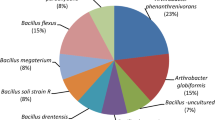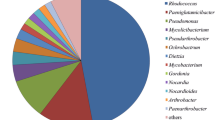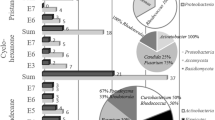Abstract
The diversity of bacteria isolated from creosote- contaminated soils in the United States, Norway, and Germany was determined by comparing their ability to degrade polycyclic aromatic hydrocarbons (PAHs), their phospholipid ester-linked fatty acid (GC-FAME) profiles, sole carbon source utilization patterns (Biolog™ assays (Use of trade names or specific products does not imply endorsement by the U.S. EPA.), and 16S rRNA sequences. Bacteria were initially obtained by enrichment with phenanthrene and fluoranthene. Many were capable of degrading a broad range of the PAHs found in creosote. Phenanthrene- or fluoranthene- degraders were abundant in most of the soils tested. Several of the fluoranthene-degrading isolates clustered with Sphingomonas (formerly Pseudomonas) paucimobilis strain EPA505 in the GC-FAME and Biolog™ analyses and three of the isolates examined by 16S rRNA sequence comparisons showed a close relationship with Sphingomonas. In addition, the Sphingomonas strains showed the most extensive degradation of 4- & 5-ring PAHs in creosote. Burkholderia cepacia strains isolated on phenanthrene from PAH-contaminated soils had limited ability to attack higher molecular weight PAHs either individually or in creosote. Thus, PAH degradation capabilities appeared to be associated with members of certain taxa, independent of the origin of the soils from which the bacteria were isolated.
Similar content being viewed by others
References
Bauer JE & Capone DG (1988) Effects of co-occurring aromatic hydrocarbons on the degradation of individual polycyclic aromatic hydrocarbons in marine sediment slurries. Appl. Environ. Microbiol. 54: 1649-1655
Berg JD, Nesgard B, Gundersen R, Lorentsen A & Bennett TE (1993) Washing and slurry phase biotreatment of creosote-contaminated soil. In: R. Hinchee (Ed) Proceedings 2nd International Symposium on In Situ and On-Site Bioreclamation (pp 489-495) San Diego, CA
Bochner BR (1989) "Breathprints" at the microbial level: An automated redox-based technology quickly identifies bacteria according to their metabolic capabilities. ASM News. 55: 536-539
Boivin-Jahns V, Bianchi A, Ruimy R, Garcin J, Daumas S & Christen R (1995) Comparison of phenotypical and molecular methods for the identification of bacterial strains isolated from a deep subsurface environment. Appl. Environ. Microbiol. 61: 3400-3406
Cerniglia CE (1992) Biodegradation of polycyclic aromatic hydrocarbons. Biodegradation. 3: 351-368
Cerniglia CE (1993) Biodegradation of polycyclic aromatic hydrocarbons. Curr. Opin. Biotechnol. 4: 331-338
Chan E-C, Kuo J, Lin H-P & Mou DG (1991) Stimulation of n-alkane conversion to dicarboxylic acid by organic-solvent-and detergent-treated microbes. Appl. Microbiol. Biotechnol. 34: 772-777
Difco Laboratories (1984) Difco manual: Dehydrated culture media and reagents for microbiology. (p 184) Difco Laboratories, Inc. Detroit, MI
Dorsch M & Stackebrandt E (1992) Some modifications in the procedure for direct sequencing of PCR amplified 16S rDNA. J. Microbiol. Methods 16: 271-279
Dyksterhouse SE, Gray JP, Herwig RP, Lara JC & Staley JT (1995) Cycloclasticus pugetii gen. nov., sp. nov., an aromatic hydrocarbon-degrading bacterium from marine sediments. Internat. J. Systematic Bacteriol. 45: 116-123
Focht JM & Westlake DWS (1988) Degradation of polycyclic aromatic hydrocarbons and aromatic heterocycles by a Pseudomonas species. Can. J. Microbiol. 34: 1135-1141
Fredrickson JK, Balkwill DL, Drake GR, Romine MF, Ringelberg DB & White DC (1995) Aromatic-degrading Sphingomonas isolates from the deep surface. Appl. Environ. Microbiol. 61: 1917-1922
García-Valdés E, Cozar E, Rotger R, Lalucat J & Ursing J (1988) New naphthalene-degrading marine Pseudomonas strains. Appl. Environ. Microbiol. 54: 2478-2485
Govindaswami M, Schmidt TM, White DC & Loper JC (1993) Phylogenetic analysis of a bacterial aerobic degrader of azo dyes. J. Bacteriol. 175: 6062-6066
Grifoll M, Selifonov SA, Gatlin CV & Chapman PJ (1995) Actions of a versatile fluorene-degrading bacterial isolate on polycyclic aromatic hydrocarbons. Appl. Environ. Microbiol. 61: 3711-3723
Grosser RJ, Warshawsky D & Vestal JR (1991) Indigenous and enhanced mineralization of pyrene, benzo[a]pyrene, and carbazole in soils. Appl. Environ. Microbiol. 57: 3462-3469
Guckert JB & White DC (1986) Phospholipid, ester-linked fatty acid analysis in microbial ecology. In: Mecusar F & Gantar M (Eds) Perspectives in Microbial Ecology (pp 455-459) Proceedings of the 4th International Symposium on Microbial Ecology. Slovene Soc. for Microbiol., Ljubljana
Guerin WF & Jones GE (1989) Estuarine ecology of phenanthrene-degrading bacteria. Estuarine Coastal Shelf Sci. 29: 115-130
Heitkamp MA & Cerniglia CE (1988) Mineralization of polycyclic aromatic hydrocarbons by a bacterium isolated from sediment below an oil field. Appl. Environ. Microbiol. 54: 1612-1614
Ho Y & Pritchard PH (1995) Classification of PAH-degrading bacteria by PAH utilization patterns and the comparison of metabolic products. Proceed. 8th International IGT Symposium on Gas, Oil, and Environmental Biotechnology, December 11-13, Colorado Springs, CO
Jacobs D (1990) SAS/GRAPH software and numerical taxonomy. In: Proceedings of the 15th Annual Users Group Conference (pp 1413-1418). SAS Institute, Inc., Cary, NC
Karlson U, Rojo F, Elsas JDV & Moore E (1996) Genetic and serological evidence for the recognition of four pentachlorophenol-degrading bacterial strains as a species of the genus Sphingomonas. System. Appl. Microbiol. (in press)
Kastner M, Breuer-Jammali M & Mahro B (1994) Enumeration and characterization of the soil microflora from hydrocarbon-contaminated soil sites able to mineralize polycyclic aromatic hydrocarbons (PAH). Appl. Microbiol. Biotechnol. 41: 267-273
Kelley I & Cerniglia CE (1991) The metabolism of fluoranthene by a species of Mycobacterium. J. Ind. Microbiol. 7: 19-26
Kiyohara H, Nagao K & Yana K (1981) Rapid screen for bacteria degrading water-insoluble, solid hydrocarbons on agar plates. Appl. Environ. Microbiol. 43: 454-457
Komukai S, Iwabuchi T, Ogawa H, Yamasoto K & Harayama S (1995) Proceed, Pseudomonas 95 Conf., Tsukuba City, Japan (p 141)
Krieger J (1992) Technique identifies bacteria that degrade wastes. Chemical and Engineering News, July 27, p. 36
Laha S & Luthy RG (1991) Inhibition of phenanthrene mineralization by nonionic surfactants in soil-water systems. Environ. Sci. Technol. 25: 1920-1930
Lane DJ (1991) 16S/23S rRNA sequencing. In: Stackebrandt E & Goodfellow M (Eds) Nucleic Acid Techniques in Bacterial Systematics (p 115-147). John Wiley & Sons, Chichester
Lane DJ, Pace B, Olsen GJ, Stahl DA, Sogin ML & Pace NR (1985) Rapid determination of 16S ribosomal RNA sequences for phylogenetic analyses. Proc. Natl. Acad. Sci. USA 82: 6955-6959
Lantz SE, Lin J-E, Mueller JG & Pritchard PH (1995) Effects of surfactants on fluoranthene mineralization by Sphingomonas paucimobilis strain EPA505. In: Hinchee RE, Vogel cm, Brockman FJ (Eds) Microbial Processes for Bioremediation (pp 7-14). Battelle Press, Columbus, OH
Lantz SE, Montogomery MT, Schultz WW, Pritchard PH, Spargo BJ, & Mueller JG (1996) Constituents of organic wood preservatives that inhibit the fluoranthene-degrading activity of Sphingomonas paucimobilis strain EPA 505. Submitted to Environ Sci Tech.
Larsen N, Olsen GJ, Maidak BL, McCaughey MJ, Overbees R, Macke TJ, Marsh TL & Woese CR (1993) Nucleic Acids Res. 21: 3021-3023
Magurran AE (1988) Ecological diversity and its measurement. Princeton University Press, Princeton, NJ. 179 pp.
Menn F-M, Applegate BM & Sayler GS (1993) NAH plasmid-mediated catabolism of anthracene and phenanthrene to naphthoic acids. Appl. Environ. Microbiol. 59: 1938-1942
MIDI, Inc. (1993) Microbial identification system operating manual. Version 4. MIDI, Inc., Newark, NJ.
Moore ERB, Wittich R-M, Fortnagel P & Timmis KN (1993) 16S ribosomal RNA gene sequence characterization and phylogenetic analysis of a dibenzo-p-dioxin-degrading isolate within the new genus Sphingomonas. Lett. Appl. Microbiol. 17: 115-118
Mueller JG, Chapman PJ & Pritchard PH (1989) Action of a fluoranthene-utilizing bacterial community on polycyclic aromatic hydrocarbon components of creosote. Appl. Environ. Microbiol. 55: 3085-3090
Mueller JG, Chapman PJ, Blattmann BO & Pritchard PH (1990) Isolation and characterization of a fluoranthene-utilizing strain of Pseudomonas paucimobilis. Appl. Environ. Microbiol. 56: 1079-1086
Mueller JG, Lantz SE, Blattmann BO & Chapman PJ (1991a) Benchscale evaluation of alternative biological treatment processes for the remediation of pentachlorophenol-and creosote-contaminated materials: Solid-phase bioremediation. Environ. Sci. Technol. 25: 1045-105
____ (1991b) Bench-scale evaluation of alternative biological treatment processes for the remediation of pentachlorophenol-and creosote-contaminated materials: Slurry-phase bioremediation. Environ. Sci. Technol. 25: 1055-1061
Mueller JG, Resnick SM, Shelton ME, & Pritchard PH (1992) Effect of inoculation of the biodegradation of weathered Prudhoe Bay crude oil. J. Indust. Microbiol. 10: 95-105
Mueller JG, Lantz SE, Colvin RJ, Ross D, Middaugh DP & Pritchard PH (1993) Strategy using bioreactors and specially-selected microorganisms for bioremediation of ground water contaminated with creosote and pentachlorophenol. Environ. Sci. Technol. 27: 691-698
Mueller JG, Lantz SE, Devereux R, Berg JD & Pritchard PH (1994) Studies on the microbial ecology of PAH biodegradation. In: Hinchee RE, Leeson A, Semprini L & Ong SK (Eds) Bioremediation of Chlorinated and Polycyclic Aromatic Hydrocarbon Compounds (pp 218-230) Lewis Publishers, Boca Raton, FL
Mueller JG, Cerniglia CE & Pritchard PH (1996) Bioremediation of environments contaminated by polycyclic aromatic hydrocarbons. In: Crawford R & Crawford D (Eds) Bioremediation: Principles and Applications. Chapter 5. Cambridge University Press
Olsen GJ, Lane DJ, Giovannoni SJ, Pace NR & Stahl DA (1986) Microbial ecology and evolution: A ribosomal RNA approach. Annu. Rev. Microbiol. 40: 57-263
Okpokwasili GC, Somerville CC, Grimes DJ & Colwell RR (1986) Plasmid-associated phenanthrene degradation by Chesapeake Bay sediment bacteria. A. Colloq. Inst. Fran. Rech. Exploit. Mer 3: 601-610
Page AL, Miller RH & Keeney DR (1982) Methods of Soil Analysis: Part 2, Chemical and Microbiological Properties, 2nd ed. American Society of Agronomy, Madison, WI, 1159 pp
Palleroni NJ (1992) Introduction to the family Pseudomonadaceae. In: Balows A, Trüper HG, Dworkon M, Harder W & Schleifer K-H (Eds) The Prokaryotes, 2nd ed. (pp 3071-3085). Springer-Verlag, New York
Palleroni NJ, Kunisawa R, Contpoulou R & Doudoroff M (1973) Nucleic acid homologies in the genus Pseudomonas. Int. J. Syst. Bacteriol. 23: 333-339
Petrasek AC, IJ Kugelman, BM Austern, TA Pressley, LA Winslow & Wise RH (1983) Fate of toxic organic compounds in wastewater treatment plants. Journal WPCF 55: 1286-1296
Phillips I (1977) Pseudomonas paucimobilis, new species isolated from human clinical specimens in the hospital environment and other sources. Int. J. Syst. Bact. 27: 133-146
Pritchard PH, Lantz SE, Lin J-E & Mueller JG (1994) Metabolic and ecological factors affecting the bioremediation of PAH-and creosote-contaminated soil and water. In: U.S. EPA Annual Symposium on Bioremediation of Hazardous Wastes: Research, Development and Field Evaluations. San Francisco, CA, June 28-30 (pp 129-138). EPA/600/R-94/075
Pritchard PH, Mueller JG, Lantz SE & Santavy DL (1995) The potential importance of biodiversity in environmental biotechnology applications: Bioremediation of PAH-contaminated soils and sediments, Chapter 9. In: Allsopp D, Hawksworth EL & Colwell RR (Eds) Microbial Diversity and Ecosystem Function. CAB International
Resnick SM & Chapman PJ (1994) Physiological properties and substrate specificity of a pentachlorophenol-degrading Pseudomonas species. Biodegradation. 5: 47-54
Schocken MJ & Gibson DT (1984) Bacterial oxidation of the polycyclic aromatic hydrocarbons acenaphthene and acenaphthylene. Appl. Environ. Microbiol. 48: 10-16
Senoo K, Nishiyama M, Wada H & Matsumoto S (1992) Differences in dynamics between indigenous and inoculated Sphingomonas paucimobilis strain SS86 in soils. FEMS Microbial Ecol. 86: 311-320
Sneath PHA & Sokal RR (1973) Numerical taxonomy. W.H. Freeman and Co., San Francisco, CA 573 pp.
Stackebrandt E, Murray RGE & Trüper HG (1988) Proteobacteria classis nov., a name for the phylogenetic taxon that includes the "purple bacteria and their relatives." Int. J. Syst. Bacteriol. 3: 321-325
Takeuchi M, Sawada H, Oyaizu H & Yokota A (1994) Phylogenetic evidence for Sphingomonas and Rhizomonas as nonphotosynthetic members of the alpha-4 subclass of the Proteobacteria. Int. J. Syst. Bacteriol. 44: 308-314
Tiehm A (1994) Degradation of polycyclic aromatic hydrocarbons in the presence of synthetic surfactants. Appl. Environ. Microbiol. 60:258-263
Tonso NL, Matheson VG & Holben WE (1995) Polyphasic characterization of a suite of bacterial isolates capable of degrading 2,4-D. Microbial Ecology 30: 3-24
van Bruggen AHC, Jochimsen KN, Steinberger EM, Segers P & Gillis M (1993) Classification of Rhizomonas suberifaciens, an unnamed Rhizomonas species, and Sphingomonas spp. in rRNA superfamily IV. Int. J. Syst. Bacteriol. 43: 1-7
Vestal JR & White DC (1989) Lipid analysis in microbial ecology. BioScience. 39: 535-541
Walter U, Beyer M, Klein J, Rehm HJ (1991) Degradation of pyrene by Rhodococcus sp. UW1. Appl. Microbiol. Biotechnol. 34: 671-676
Weisburg WG, Barnes SM, Pelleteir DA & Lane DJ (1991) 16S ribosomal DNA amplification for phylogenetic study. J. Bacteriol. 173: 697-703
Weissenfels WD, Beyer M & Klein J (1990) Degradation of phenanthrene, fluorene and fluoranthene by pure bacterial cultures. Appl. Microbiol. Biotechnol. 32: 479-484
West PA, Okpokwasili GC, Brayton PR, Grimes DJ & Colwell RR (1984) Numerical taxonomy of phenanthrene-degrading bacteria isolated from the Chesapeake Bay. Appl. Environ. Microbiol. 48: 988-993
Yabuuchi E, Yano I, Oyaizu H, Hashimoto Y, Ezaki T & Yamamoto H (1990) Proposals of Sphingomonas paucimobilis gen. nov. and comb. nov., Sphingomonas parapaucimobilis sp. nov., Sphingomonas yanoikuyae sp. nov., Sphingomonas adhaesiva sp. nov., Sphingomonas capsulata comb. nov., and two genospecies of the genus Sphingomonas. Microbiol. Immunol. 34: 99-119
Yabuuchi E, Kosako Y, Oyaizu H, Yano I, Hotta H, Hashimoto Y, Ezaki T & Arakawa M (1992) Proposal of Burkholderia gen. nov. and transfer of seven species of the genus Pseudomonas homology group II to the new genus, with the type species Burkholderia cepacia (Palleroni and Holmes, 1981) comb. nov. Microbiol. Immunol. 36: 1251-1275
Zylstra GJ & Gibson DT (1991) Aromatic hydrocarbon degradation: A molecular approach. In: Setlow JK (Ed) Genetic Engineering: Principles and Methods, Vol. 13 (pp 183-203). Plenum Press, New York
Author information
Authors and Affiliations
Rights and permissions
About this article
Cite this article
Mueller, J., Devereux, R., Santavy, D. et al. Phylogenetic and physiological comparisons of PAH-degrading bacteria from geographically diverse soils. Antonie Van Leeuwenhoek 71, 329–343 (1997). https://doi.org/10.1023/A:1000277008064
Issue Date:
DOI: https://doi.org/10.1023/A:1000277008064




